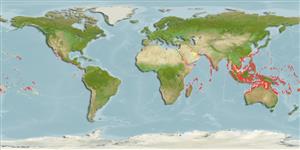Teleostei (teleosts) >
Anguilliformes (Eels and morays) >
Muraenidae (Moray eels) > Muraeninae
Etymology: Gymnomuraena: Greek, gymnos = naked + Latin, muraena = morey eel (Ref. 45335).
More on author: Shaw.
Environment: milieu / climate zone / depth range / distribution range
Ecology
Marine; reef-associated; depth range 3 - 50 m (Ref. 30573). Tropical; 30°N - 24°S, 32°E - 78°W
Indo-Pacific: Red Sea and East Africa (Ref. 33390) and Persian Gulf (Ref. 68964) to the Society Islands, north to the Ryukyu and Hawaiian islands, south to the Great Barrier Reef. Eastern Central Pacific: southern Baja California, Mexico and from Guatemala to northern Colombia, including the Galapagos (Ref. 9324).
Size / Weight / Age
Maturity: Lm ? range ? - ? cm
Max length : 150 cm TL male/unsexed; (Ref. 1602); common length : 50.0 cm TL male/unsexed; (Ref. 30573)
A secretive inhabitant of sandy and rocky bottoms, crevices and ledges of seaward reefs. It feeds primarily on xanthid crabs, but also on other crustaceans, mollusks and sea urchins (Ref. 9710, 48635). Benthic from 1-39 m, usually at <4 m (Ref. 58302). Possibly a protogynous hermaphrodite (Ref. 32169). Minimum depth reported taken from Ref. 30874.
Life cycle and mating behavior
Maturity | Reproduction | Spawning | Eggs | Fecundity | Larvae
Protogyny unconfirmed (Ref. 84746).
Chen, H.-M., K.-T. Shao and C.T. Chen, 1994. A review of the muraenid eels (Family Muraenidae) from Taiwan with descriptions of twelve new records. Zool. Stud. 33(1):44-64. (Ref. 6934)
IUCN Red List Status (Ref. 130435: Version 2024-1)
Threat to humans
Harmless
Human uses
Fisheries: minor commercial; aquarium: commercial
Tools
Special reports
Download XML
Internet sources
Estimates based on models
Preferred temperature (Ref.
123201): 24.7 - 29.1, mean 28 °C (based on 1176 cells).
Phylogenetic diversity index (Ref.
82804): PD
50 = 1.0000 [Uniqueness, from 0.5 = low to 2.0 = high].
Bayesian length-weight: a=0.00049 (0.00024 - 0.00099), b=3.26 (3.10 - 3.42), in cm total length, based on LWR estimates for this (Sub)family-body shape (Ref.
93245).
Trophic level (Ref.
69278): 3.8 ±0.33 se; based on food items.
Resilience (Ref.
120179): Very Low, minimum population doubling time more than 14 years (Preliminary K or Fecundity.).
Fishing Vulnerability (Ref.
59153): Very high vulnerability (90 of 100).
Nutrients (Ref.
124155): Calcium = 22.3 [11.4, 34.8] mg/100g; Iron = 0.405 [0.239, 0.854] mg/100g; Protein = 18.6 [16.3, 21.1] %; Omega3 = 0.088 [0.038, 0.242] g/100g; Selenium = 54.4 [28.4, 107.5] μg/100g; VitaminA = 43.1 [11.3, 148.7] μg/100g; Zinc = 0.944 [0.659, 1.328] mg/100g (wet weight);
